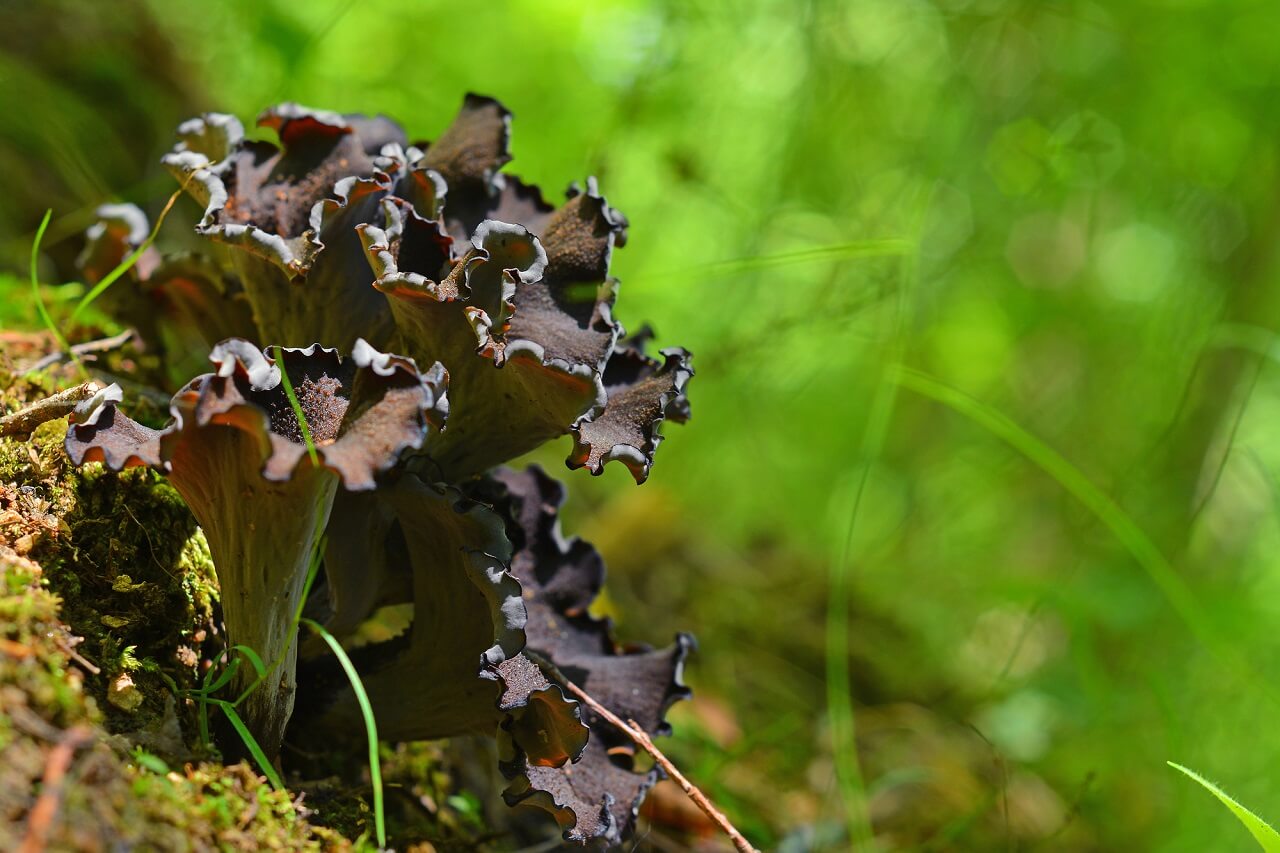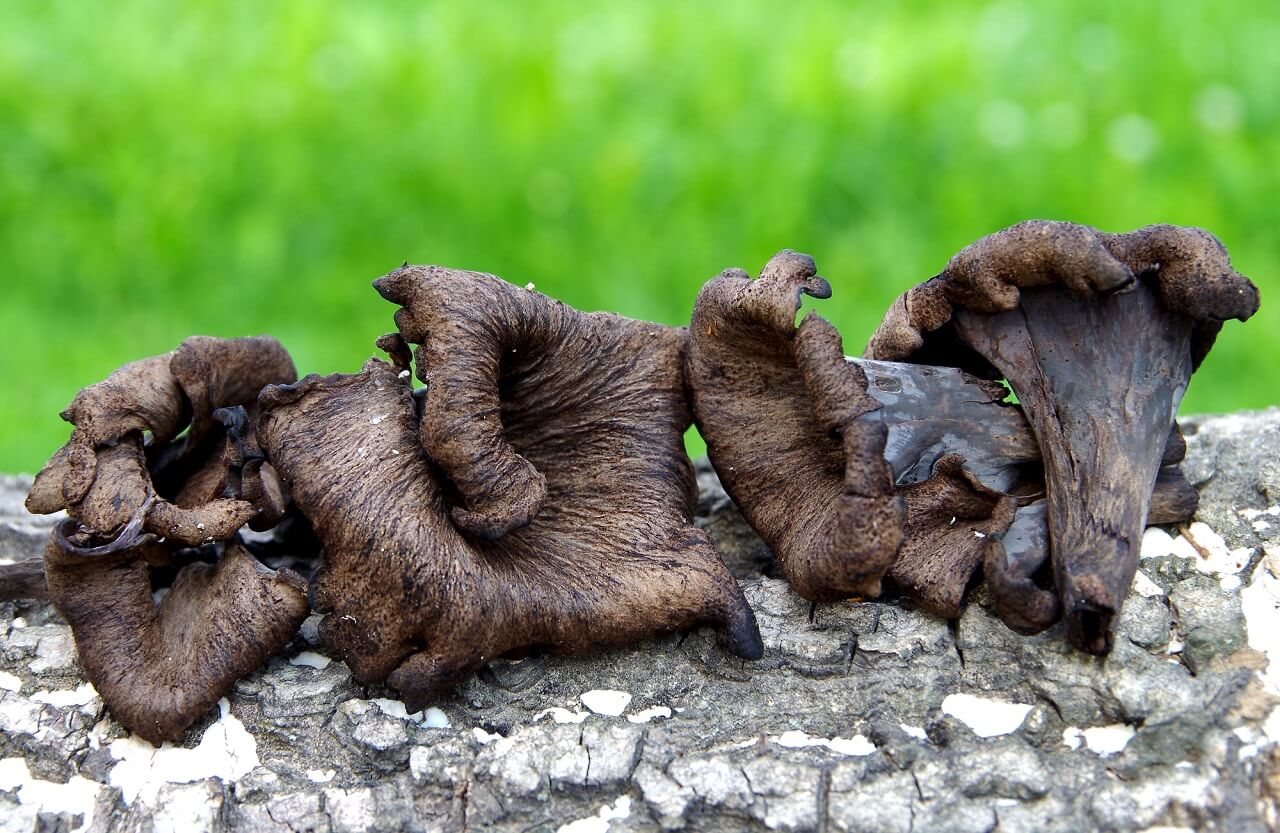If you’re new to foraging mushrooms, why not start by looking for black trumpets? These choice edible mushrooms can be a little tricky to find, but they have no toxic look-alikes. Read on to learn more about where to find black trumpet mushrooms. We’ll also discuss how to identify them and when is the best time to find them.
What You'll Learn Today
Where Do Black Trumpet Mushrooms Grow?

Black trumpets grow well in warm, humid, shady conditions. They are commonly found in hardwood forests or in shady areas near hardwood trees.
The mushrooms don’t grow directly on wood. For example, you won’t find them growing on tree trunks, on fallen trees, or directly on top of forest debris.
Black trumpets grow out of the ground rather than on top of it – they feel “rooted” to the dirt and have to be pulled up carefully to avoid damaging their delicate stems.
They grow well in mossy areas. It is not uncommon to find clustered or densely growing black trumpets sprouting directly from patches of moss.
Where Can I Find Black Trumpets?
If you’re foraging for wild black trumpets, start out by looking in any wild forested area in your region. Hardwood forests are the best, but you can check any area with a thick stand of trees and a water source.
Black trumpets grow during the late summer and fall in most regions. They do best if there is plenty of shade and moisture.
If you don’t find any at first, don’t give up! You may have to look closely as they often blend in with the forest floor, or you may have to explore different areas to find where they thrive the best.
If you want to skip the foraging part but would like to try eating black trumpets, you may be able to find them at a local farmer’s market or at small, locally owned shops while they’re in season. They are rarely sold at stores, as they are not easily cultivated and generally have to be foraged from the wild.
Some local restaurants may offer black trumpets seasonally, especially restaurants with gourmet options.
The best way to get your fill of black trumpets is to forage them yourself. If you’ve never done it before, check out the video below to learn more about identifying and collecting black trumpets.
Are Black Trumpet Mushrooms Rare?
Black trumpets aren’t rare exactly, but they can be hard to find, both in the wild and in previously harvested.
For one thing, these mushrooms only grow for a short period of time each year. They can be dried and preserved for a longer period of time, but they are only in season for a few weeks to a few months.
Black trumpets require a very specific set of growing conditions, which makes them difficult to cultivate. Because they can’t be grown in mass or on demand, they are very rarely available to buy, and when they are they’re usually quite expensive.
When they’re growing wild, they can be very challenging to spot. Their dark coloring and low-growing habits often cause them to blend in with their surroundings.
So, if you’re out foraging and you don’t find any black trumpets, you may just have to look a little closer. Or, you may have to look in a different area with more hardwood trees or different growing conditions.
How Do You Identify a Black Trumpet?
One thing that’s great about black trumpet mushrooms is that they’re easy to identify in the wild. They have very few look-alikes, and none that are poisonous.
If you are familiar with wild mushroom foraging but have never seen a black trumpet, look for mushrooms similar in appearance to chanterelles. Instead of the bright chanterelle colors, though black trumpets will be black, brown, or gray in color.
Black trumpets are shaped somewhat like a bugle or a horn of plenty, with a hollow stem widening to a funnel-shaped cap. The cap will likely have ruffled edges.
The stems of black trumpets are tender and can be damaged easily, so you’ll want to be careful when harvesting them. The whole mushroom is usually smooth, without ridges or veins, though some may have a mottled or rough texture.
When to Pick Black Trumpet Mushrooms?

When exactly black trumpets are in season depends on the area. They usually grow during summer and fall, but the exact timeframe will vary.
The black trumpet season may extend into early winter in warmer regions, such as parts of California. On the other hand, according to Michigan.Gov, black trumpets are only found from July through October in that state.
Regardless of what is normal in a given region, black trumpets may begin to die off early in areas with stretches of unseasonably cool and dry weather.
If you find a patch of black trumpets, you may also be wondering at what size to pick them. How will you know if they are mature enough, and is it possible for them to become too old and tough?
Black trumpets should be picked when they are at least 1 to 3 inches tall and funnel shaped. If they have only begun to poke out of the ground or they don’t have much of a shape yet, leave them for another day or two.
Any mushrooms that look old, broken, or partially rotted should be left. The longer a black trumpet grows, the tougher and woodier it will be, so it’s best to harvest them when they look young and fresh.
Conclusion
Black trumpet mushrooms grow near hardwood trees and are prevalent in some forests. They need warm, humid, shady conditions to thrive.
The best way to get black trumpets is to forage for them yourself, as they are not readily available at most stores and will be expensive if you do find them for sale. Once you find where they grow in your area, harvest them during the summer and fall months.
Thank you for the information, but to be honest, I rarely see black trumpet mushrooms in the wood.